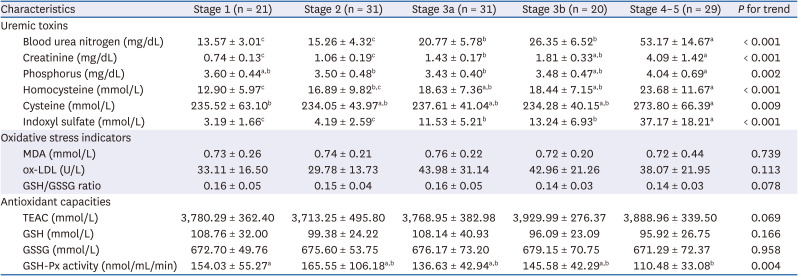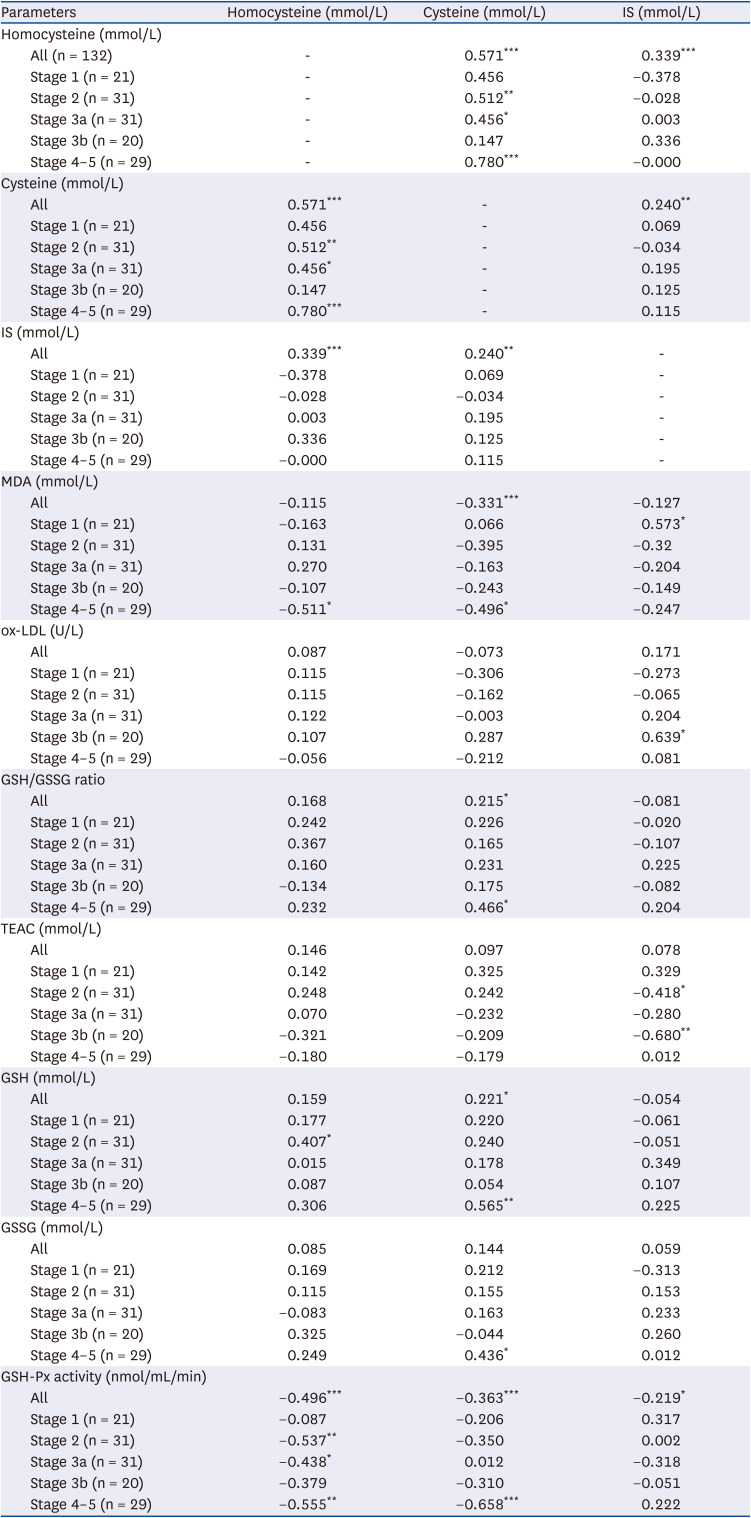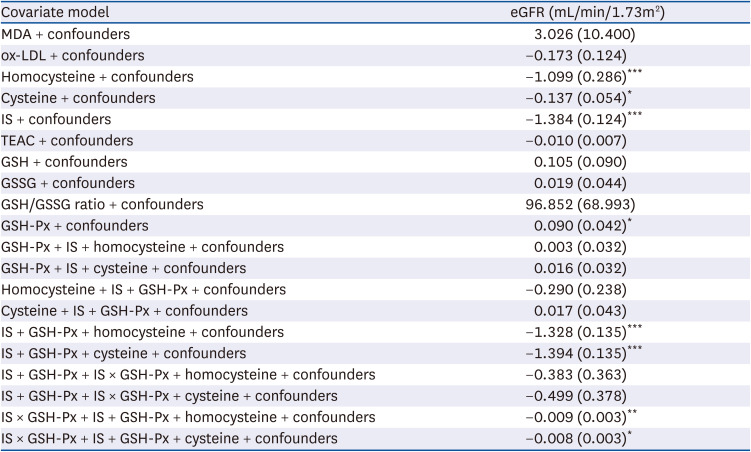1. Vanholder R, De Smet R, Glorieux G, Argilés A, Baurmeister U, Brunet P, Clark W, Cohen G, De Deyn PP, Deppisch R, et al. Review on uremic toxins: classification, concentration, and interindividual variability. Kidney Int. 2003; 63:1934–1943. PMID:
12675874.

2. Rossi M, Campbell KL, Johnson DW. Indoxyl sulphate and p-cresyl sulphate: therapeutically modifiable nephrovascular toxins. OA Nephrol. 2013; 1:13.

3. Vanholder R, De Smet R, Lameire N. Protein-bound uremic solutes: the forgotten toxins. Kidney Int Suppl. 2001; 78:S266–S270. PMID:
11169024.

4. Liu WC, Tomino Y, Lu KC. Impacts of indoxyl sulfate and p-cresol sulfate on chronic kidney disease and mitigating effects of AST-120. Toxins (Basel). 2018; 10:367.

5. Niwa T. Uremic toxicity of indoxyl sulfate. Nagoya J Med Sci. 2010; 72:1–11. PMID:
20229698.
6. Lin CJ, Chen HH, Pan CF, Chuang CK, Wang TJ, Sun FJ, Wu CJ. p-Cresylsulfate and indoxyl sulfate level at different stages of chronic kidney disease. J Clin Lab Anal. 2011; 25:191–197. PMID:
21567467.

7. Levi A, Cohen E, Levi M, Goldberg E, Garty M, Krause I. Elevated serum homocysteine is a predictor of accelerated decline in renal function and chronic kidney disease: a historical prospective study. Eur J Intern Med. 2014; 25:951–955. PMID:
25457436.

8. Chen CH, Yang WC, Hsiao YH, Huang SC, Huang YC. High homocysteine, low vitamin B-6, and increased oxidative stress are independently associated with the risk of chronic kidney disease. Nutrition. 2016; 32:236–241. PMID:
26526964.

9. Hoffman M. Hypothesis: hyperhomocysteinemia is an indicator of oxidant stress. Med Hypotheses. 2011; 77:1088–1093. PMID:
21963358.

10. Long Y, Nie J. Homocysteine in renal injury. Kidney Dis (Basel). 2016; 2:80–87. PMID:
27536696.

11. Sun CY, Hsu HH, Wu MS. p-Cresol sulfate and indoxyl sulfate induce similar cellular inflammatory gene expressions in cultured proximal renal tubular cells. Nephrol Dial Transplant. 2013; 28:70–78. PMID:
22610984.

12. Gouroju S, Rao PVLNS, Bitla AR, Vinapamula KS, Manohar SM, Vishnubhotla S. Role of gut-derived uremic toxins on oxidative stress and inflammation in patients with chronic kidney disease. Indian J Nephrol. 2017; 27:359–364. PMID:
28904431.

13. Stoyanova E, Sandoval SB, Zúñiga LA, El-Yamani N, Coll E, Pastor S, Reyes J, Andrés E, Ballarin J, Xamena N, et al. Oxidative DNA damage in chronic renal failure patients. Nephrol Dial Transplant. 2010; 25:879–885. PMID:
19889871.

14. Sahni N, Gupta KL, Rana SV, Prasad R, Bhalla AK. Intake of antioxidants and their status in chronic kidney disease patients. J Ren Nutr. 2012; 22:389–399. PMID:
22227184.

15. Sung CC, Hsu YC, Chen CC, Lin YF, Wu CC. Oxidative stress and nucleic acid oxidation in patients with chronic kidney disease. Oxid Med Cell Longev. 2013; 2013:301982. PMID:
24058721.

16. Xu G, Luo K, Liu H, Huang T, Fang X, Tu W. The progress of inflammation and oxidative stress in patients with chronic kidney disease. Ren Fail. 2015; 37:45–49. PMID:
25375354.

17. Avissar N, Ornt DB, Yagil Y, Horowitz S, Watkins RH, Kerl EA, Takahashi K, Palmer IS, Cohen HJ. Human kidney proximal tubules are the main source of plasma glutathione peroxidase. Am J Physiol. 1994; 266:C367–C375. PMID:
8141250.

18. Brown KM, Arthur JR. Selenium, selenoproteins and human health: a review. Public Health Nutr. 2001; 4:593–599. PMID:
11683552.

19. Zachara BA, Salak A, Koterska D, Manitius J, Wasowicz W. Selenium and glutathione peroxidases in blood of patients with different stages of chronic renal failure. J Trace Elem Med Biol. 2004; 17:291–299. PMID:
15139391.

20. Johnson-Davis KL, Fernelius C, Eliason NB, Wilson A, Beddhu S, Roberts WL. Blood enzymes and oxidative stress in chronic kidney disease: a cross sectional study. Ann Clin Lab Sci. 2011; 41:331–339. PMID:
22166502.
21. Zargari M, Sedighi O. Influence of hemodialysis on lipid peroxidation, enzymatic and non-enzymatic antioxidant capacity n chronic renal failure patients. Nephrourol Mon. 2015; 7:e28526. PMID:
26539417.

22. Himmelfarb J, Stenvinkel P, Ikizler TA, Hakim RM. The elephant in uremia: oxidant stress as a unifying concept of cardiovascular disease in uremia. Kidney Int. 2002; 62:1524–1538. PMID:
12371953.

23. Khazim K, Giustarini D, Rossi R, Verkaik D, Cornell JE, Cunningham SED, Mohammad M, Trochta K, Lorenzo C, Folli F, et al. Glutathione redox potential is low and glutathionylated and cysteinylated hemoglobin levels are elevated in maintenance hemodialysis patients. Transl Res. 2013; 162:16–25. PMID:
23333585.

24. Tucker PS, Dalbo VJ, Han T, Kingsley MI. Clinical and research markers of oxidative stress in chronic kidney disease. Biomarkers. 2013; 18:103–115. PMID:
23339563.

25. KDIGO CKD Work Group. KDIGO 2012 clinical practice guideline for the evaluation and management of chronic kidney disease. Kidney Int Suppl. 2013; 3:1–150.
26. Araki A, Sako Y. Determination of free and total homocysteine in human plasma by high-performance liquid chromatography with fluorescence detection. J Chromatogr A. 1987; 422:43–52.

27. Cheng FP, Hsieh MJ, Chou CC, Hsu WL, Lee YJ. Detection of indoxyl sulfate levels in dogs and cats suffering from naturally occurring kidney diseases. Vet J. 2015; 205:399–403. PMID:
26118479.

28. Lapenna D, Ciofani G, Pierdomenico SD, Giamberardino MA, Cuccurullo F. Reaction conditions affecting the relationship between thiobarbituric acid reactivity and lipid peroxides in human plasma. Free Radic Biol Med. 2001; 31:331–335. PMID:
11461770.

29. Arnao MB, Cano A, Hernández-Ruiz J, García-Cánovas F, Acosta M. Inhibition by L-ascorbic acid and other antioxidants of the 2.2′-azino-bis(3-ethylbenzthiazoline-6-sulfonic acid) oxidation catalyzed by peroxidase: a new approach for determining total antioxidant status of foods. Anal Biochem. 1996; 236:255–261. PMID:
8660502.

30. Zachara BA, Adamowicz A, Trafikowska U, Pilecki A, Manitius J. Decreased plasma glutathione peroxidase activity in uraemic patients. Nephron. 2000; 84:278–281. PMID:
10720902.

31. Kuchta A, Pacanis A, Kortas-Stempak B, Cwiklińska A, Ziętkiewicz M, Renke M, Rutkowski B. Estimation of oxidative stress markers in chronic kidney disease. Kidney Blood Press Res. 2011; 34:12–19. PMID:
21071957.

32. Zachara BA, Gromadzińska J, Wąsowicz W, Zbróg Z. Red blood cell and plasma glutathione peroxidase activities and selenium concentration in patients with chronic kidney disease: a review. Acta Biochim Pol. 2006; 53:663–677. PMID:
17160142.

33. Ceballos-Picot I, Witko-Sarsat V, Merad-Boudia M, Nguyen AT, Thévenin M, Jaudon MC, Zingraff J, Verger C, Jungers P, Descamps-Latscha B. Glutathione antioxidant system as a marker of oxidative stress in chronic renal failure. Free Radic Biol Med. 1996; 21:845–853. PMID:
8902530.

34. Lasseur C, Parrot F, Delmas Y, Level C, Ged C, Redonnet-Vernhet I, Montaudon D, Combe C, Chauveau P. Impact of high-flux/high-efficiency dialysis on folate and homocysteine metabolism. J Nephrol. 2001; 14:32–35. PMID:
11281342.
35. Wrone EM, Hornberger JM, Zehnder JL, McCann LM, Coplon NS, Fortmann SP. Randomized trial of folic acid for prevention of cardiovascular events in end-stage renal disease. J Am Soc Nephrol. 2004; 15:420–426. PMID:
14747389.

36. Rossi M, Campbell K, Johnson D, Stanton T, Pascoe E, Hawley C, Dimeski G, McWhinney B, Ungerer J, Isbel N. Uraemic toxins and cardiovascular disease across the chronic kidney disease spectrum: an observational study. Nutr Metab Cardiovasc Dis. 2014; 24:1035–1042. PMID:
24880738.

37. Xie T, Bao M, Zhang P, Jiao X, Zou J, Ding X, Cao X, Yu X. Serum concentration of indoxyl sulfate in peritoneal dialysis patients and low-flux hemodialysis patients. Blood Purif. 2019; 48:183–190. PMID:
31039561.

38. Vanholder R, Schepers E, Pletinck A, Nagler EV, Glorieux G. The uremic toxicity of indoxyl sulfate and p-cresyl sulfate: a systematic review. J Am Soc Nephrol. 2014; 25:1897–1907. PMID:
24812165.

39. Milanesi S, Garibaldi S, Saio M, Ghigliotti G, Picciotto D, Ameri P, Garibotto G, Barisione C, Verzola D. Indoxyl sulfate induces renal fibroblast activation through a targetable heat shock protein 90-dependent pathway. Oxid Med Cell Longev. 2019; 2019:2050183. PMID:
31178953.

40. Nakano T, Katsuki S, Chen M, Decano JL, Halu A, Lee LH, Pestana DVS, Kum AST, Kuromoto RK, Golden WS, et al. Uremic toxin indoxyl sulfate promotes proinflammatory macrophage activation via the interplay of OATP2B1 and DII4-Notch signaling. Circulation. 2019; 139:78–96. PMID:
30586693.

41. Kamiński TW, Pawlak K, Karbowska M, Myśliwiec M, Pawlak D. Indoxyl sulfate - the uremic toxin linking hemostatic system disturbances with the prevalence of cardiovascular disease in patients with chronic kidney disease. BMC Nephrol. 2017; 18:35. PMID:
28122514.

42. Hung SC, Kuo KL, Wu CC, Tarng DC. Indoxyl sulfate: a novel cardiovascular risk factor in chronic kidney disease. J Am Heart Assoc. 2017; 6:e005022. PMID:
28174171.

43. Fan PC, Chang JC, Lin CN, Lee CC, Chen YT, Chu PH, Kou G, Lu YA, Yang CW, Chen YC. Serum indoxyl sulfate predicts adverse cardiovascular events in patients with chronic kidney disease. J Formos Med Assoc. 2019; 118:1099–1106. PMID:
30928187.

44. Barisione C, Ghigliotti G, Canepa M, Balbi M, Brunelli C, Ameri P. Indoxyl sulfate: a candidate target for the prevention and treatment of cardiovascular disease in chronic kidney disease. Curr Drug Targets. 2015; 16:366–372. PMID:
25537654.

45. Shimizu H, Bolati D, Adijiang A, Muteliefu G, Enomoto A, Nishijima F, Dateki M, Niwa T. NF-κB plays an important role in indoxyl sulfate-induced cellular senescence, fibrotic gene expression, and inhibition of proliferation in proximal tubular cells. Am J Physiol Cell Physiol. 2011; 301:C1201–C1212. PMID:
21832251.

46. Yu M, Kim YJ, Kang DH. Indoxyl sulfate-induced endothelial dysfunction in patients with chronic kidney disease via an induction of oxidative stress. Clin J Am Soc Nephrol. 2011; 6:30–39. PMID:
20876676.

47. Dou L, Jourde-Chiche N, Faure V, Cerini C, Berland Y, Dignat-George F, Brunet P. The uremic solute indoxyl sulfate induces oxidative stress in endothelial cells. J Thromb Haemost. 2007; 5:1302–1308. PMID:
17403109.

48. Sirich TL, Plummer NS, Gardner CD, Hostetter TH, Meyer TW. Effect of increasing dietary fiber on plasma levels of colon-derived solutes in hemodialysis patients. Clin J Am Soc Nephrol. 2014; 9:1603–1610. PMID:
25147155.

49. Rossi M, Johnson DW, Xu H, Carrero JJ, Pascoe E, French C, Campbell KL. Dietary protein-fiber ratio associates with circulating levels of indoxyl sulfate and p-cresyl sulfate in chronic kidney disease patients. Nutr Metab Cardiovasc Dis. 2015; 25:860–865. PMID:
26026209.









 PDF
PDF Citation
Citation Print
Print



 XML Download
XML Download